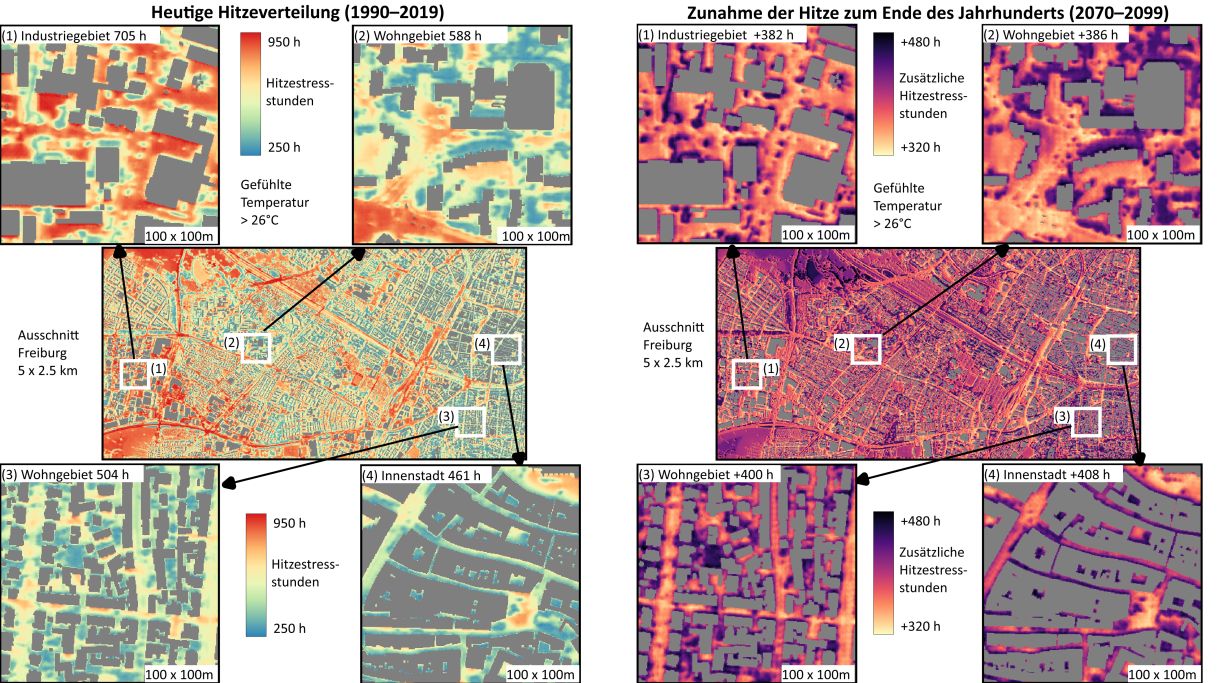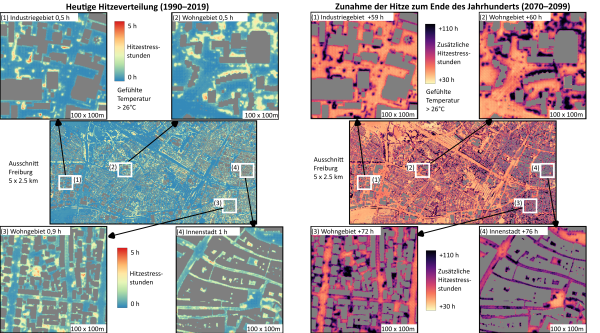
Cities are particularly vulnerable to heat stress because paved and densely built-up areas tend to store the heat. More frequent and intense heatwaves are a growing challenge for public health and urban infrastructure. A new deep-learning based model developed by the University of Freiburg and Karlsruhe Institute of Technology (KIT) calculates for the first time how heat stress will develop on each square meter of a city in the future. The model supports cities in their efforts to adapt to the climate change and provides stimuli for climate-friendly urban planning. Published in Urban Climate. (DOI: 10.1016/j.uclim.2025.102564 )
An interdisciplinary team of researchers from the University of Freiburg and KIT developed a deep learning model to calculate at high resolution and over long periods of time how heat stress in urban areas would develop per square meter in the future. The researchers used the city of Freiburg for a case study. The deep-learning system combines geodata such as building heights and vegetation structures with weather forecasts or climate projection data such as air temperature and radiation. The model is suitable for predicting different climate scenarios, from a climate where warming is reduced due to effective climate protection measures to a significantly warmer climate because of very high greenhouse gas emissions.
Increasing Heat Stress Expected for Freiburg
Using the deep learning model, the researchers simulated the future urban climate in Freiburg for 2070 to 2099 based on three scenarios. In the most pessimistic scenario, up to 307 hours per year with a strong heat stress of over 32 degrees Celsius "perceived" temperature during the day would be possible. In the reference period between 1990 and 2019, there were only 135 hours per year. The number of hours with very strong heat stress of over 38 degrees Celsius "perceived" temperature might even increase by a factor of ten: 71 hours a year in the period between 2070 and 2099, compared to seven hours a year during the reference period. In comparison, the number of strong heat stress hours in the lowest-warming scenario only increases to 149 per year. In this scenario, the number of hours with very strong heat stress amounts to twelve.
The effects of heat stress within a city are diverse. "Factors such as the density of development, the vegetation, and the air circulation determine whether an area will remain comparably cool or whether the heat accumulates," explains Dr. Ferdinand Briegel, lead author of the study and postdoctoral researcher at KIT's Institute of Meteorology and Climate Research.
The aim of the study is to measure the heat stress affecting representative urban areas in Freiburg, i.e. an industrial zone, a residential area with old trees, and the historic city center with mid-rise buildings and little vegetation. The results show that the number of heat hours increases particularly in industrial zones because of its many paved surfaces and little shadowing. "Densely developed areas with old trees cast shadows during the day so that the heat hours increase moderately. In the night, however, this building and tree structure slows down the cooling process so that the heat stays on," says Briegel.

"With our deep leaning model, we can analyze heat development virtually in the neighborhood scale," says Professor Andreas Christen, Chair of Environmental Meteorology at the University of Freiburg. "Since each city features its own development, greening, and geographical location, and thus has an individual structure, it is crucial to calculate the heat stress as granularly as possible. This is the only way to develop custom measures that can protect the inhabitants effectively from extreme heat." After validation and adaptation to specific conditions, the model can be customized and used for any other city.
In the next funding period of the Helmholtz Association, urban research will be a central topic for the first time. Cooperations such as this one between KIT and the University of Freiburg show how important networked research for significant future-related topics is.
Originalpublikation
Ferdinand Briegel, Simon Schrodi, Markus Sulzer, Thomas Brox, Joaquim G. Pinto, Andreas Christen: Deep learning enables city-wide climate projections of street-level heat stress. Urban Climate, 2025. DOI: 10.1016/j.uclim.2025.102564
More information on the KIT Climate and Environment Center
Being "The Research University in the Helmholtz Association", KIT creates and imparts knowledge for the society and the environment. It is the objective to make significant contributions to the global challenges in the fields of energy, mobility, and information. For this, about 10,000 employees cooperate in a broad range of disciplines in natural sciences, engineering sciences, economics, and the humanities and social sciences. KIT prepares its 22,800 students for responsible tasks in society, industry, and science by offering research-based study programs. Innovation efforts at KIT build a bridge between important scientific findings and their application for the benefit of society, economic prosperity, and the preservation of our natural basis of life. KIT is one of the German universities of excellence.






